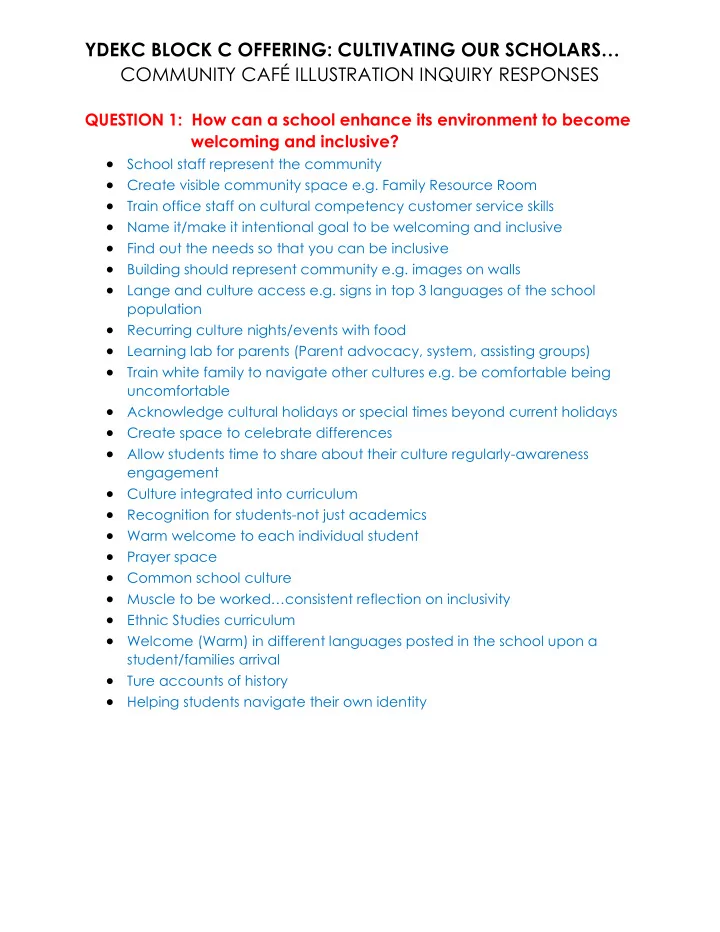

YDEKC BLOCK C OFFERING: CULTIVATING OUR SCHOLARS… COMMUNITY CAFÉ ILLUSTRATION INQUIRY RESPONSES QUESTION 1: How can a school enhance its environment to become welcoming and inclusive? School staff represent the community Create visible community space e.g. Family Resource Room Train office staff on cultural competency customer service skills Name it/make it intentional goal to be welcoming and inclusive Find out the needs so that you can be inclusive Building should represent community e.g. images on walls Lange and culture access e.g. signs in top 3 languages of the school population Recurring culture nights/events with food Learning lab for parents (Parent advocacy, system, assisting groups) Train white family to navigate other cultures e.g. be comfortable being uncomfortable Acknowledge cultural holidays or special times beyond current holidays Create space to celebrate differences Allow students time to share about their culture regularly-awareness engagement Culture integrated into curriculum Recognition for students-not just academics Warm welcome to each individual student Prayer space Common school culture Muscle to be worked…consistent reflection on inclusivity Ethnic Studies curriculum Welcome (Warm) in different languages posted in the school upon a student/families arrival Ture accounts of history Helping students navigate their own identity
YDEKC BLOCK C OFFERING: CULTIVATING OUR SCHOLARS… COMMUNITY CAFÉ ILLUSTRATION INQUIRY RESPONSES QUESTION 2: How can a school enhance its communication to families to be inclusive? Be comfortable with discomfort Tap into family wisdom Open to emotions with interactions with families Letters in different languages Other ways of communications e.g. email, phone and face-to-face Home visits Interpreters always available with outreach Contact through phone tree Be transparent Full disclosure Have empathy Community champions or point persons in the community to get the word out and support family engagement efforts Discussion boards in many languages Healing circles….opportunities for connection Include extended family Recognize different family structures Multiple contacts Acknowledge language barriers and ask to learn words/phrases in other languages Ongoing designated school point of contact Have platform for families to share/ask questions Open ended questions Family input on what is communicated Yes, and everything written on question 3 Structure-evening office hours Open doors to families/holding office at community locations that are outside of the school Culturally appropriate sensitivity training for teachers and staff
Thoroughly train regarding the impact of Bias/White Privilege/Microaggressions Respectful time for families to access school Authentically listening to families Train families on cultural competency Schools solicit feedback from families Interpretation at school events In person interpretation at IEP Meetings Train school staff on how to use the phone with interpretation Schools need to be consistent in best practices with family communications throughout the school year and summer Talk to families, not at families
YDEKC BLOCK C OFFERING: CULTIVATING OUR SCHOLARS… COMMUNITY CAFÉ ILLUSTRATION INQUIRY RESPONSES QUESTION 3: How can kinship networks or community members be empowered or leveraged to support Question 2? Parent School community newsletter Linguistic representation Religious holidays represented Keeping SES in time Accessing and utilizing community resources Parent community representation Seeking feedback from community Supporting community school communication Setting up the room to represent community Community sensitive schedules Gender neutral language Families vs. parents Recognizing affinity groups at the school Assuming trust and positive intentions with the school Strong connection/communication by the community organizations families and schools Diverse ways to communicate in home language: Email, call, paper, text, verbal Parent cultural language representative Communication sender (teacher, admin, etc.) should do home visits with community-based organizations Diversity represented in family networks accessed by schools (culture, gender, ethnic, ability, identity) policy tagline on letters and communication Have affinity groups identity leadership to represent Transparency induces the trust necessary for communication guidelines Gathers accurate demographic information
YDEKC BLOCK C OFFERING: CULTIVATING OUR SCHOLARS… COMMUNITY CAFÉ ILLUSTRATION INQUIRY RESPONSES QUESTION 4: What can a school do to help an individual feel confident to share concerns/observations with someone at school? e.g. teacher, principal, counselor, administrator, etc. Safe space/opportunity to share concerns e.g. Community Cafe Variety of people receiving message Principal office hours Cultural nights Action after concerns are raised/recognizing root issues Principal “Office Hours” Communicating positives Confidence in administration’s ability to make a change Specific point of contact Layout of office space/welcoming space Proper signage in varieties of languages Intentional selection of trusted adults Clear and consistent action plans Follow up and consistency Relationship building Acknowledging cultural differences Equitable partnerships leadership with meaningful roles that empower individuals to know their voice is respected and invited Champions Café Model/Open Forum Feedback night Empathy Climate adjustments Severity of needs vs welcoming space Building accessibility Cultivating representative art TRUST/RELATIONSHIP
Accountability/feedback training Empowering families to represent themselves and culture Recognizing when people are expected to “code switch” Cultural representations of stories and integrating multiple lenses in observing a situation Age appropriate/developmentally appropriate reaffirming communication
Recommend
More recommend